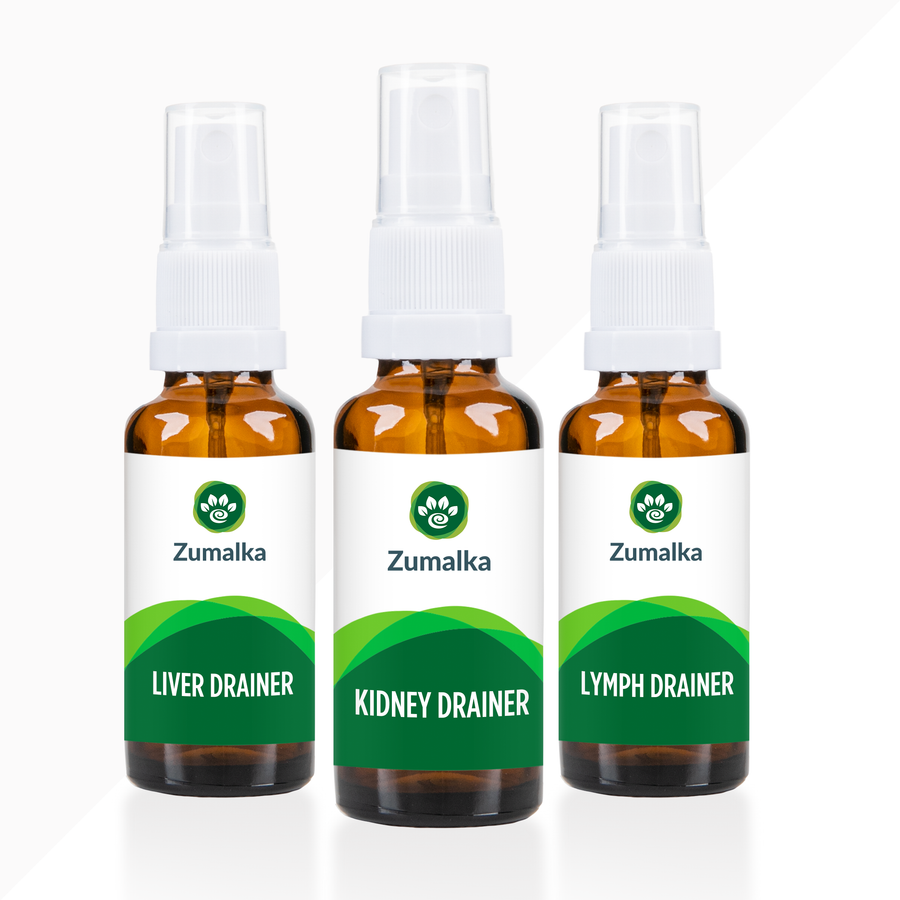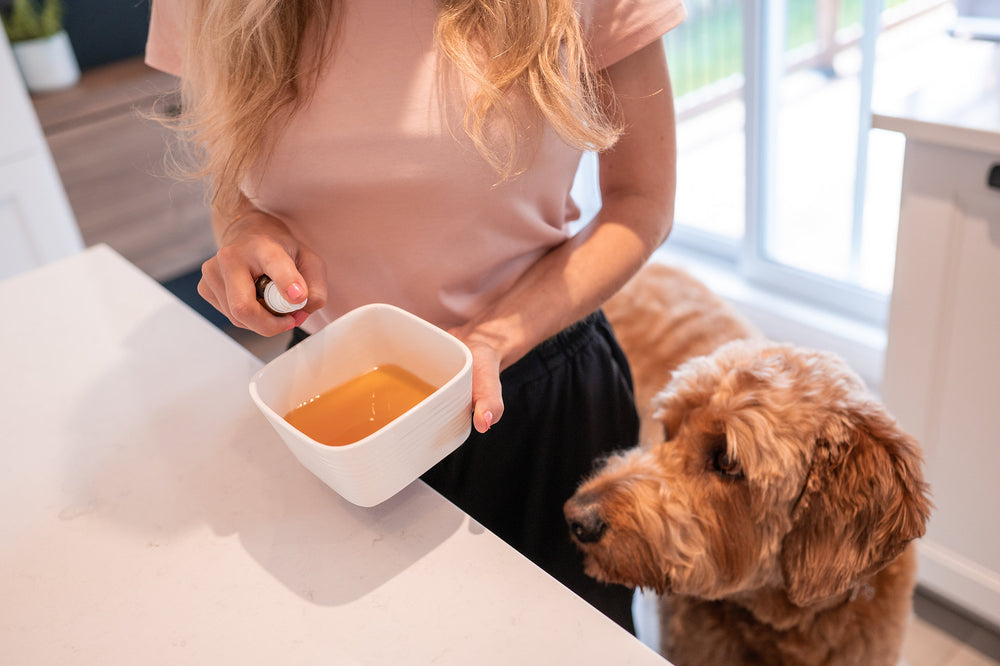Dog Bad Breath? 8 Vet-Verified Natural Remedies for a Fresher Mouth
List of Contents
While occasional "dog breath" is common, persistent bad breath isn’t normal and can interfere with close, loving moments. Chronic bad breath or canine halitosis often signals an underlying health issue that needs attention, not just a smelly inconvenience.
In this article, you’ll discover 8 natural ways to freshen your dog’s breath safely and effectively. We’ll also cover common causes, essential dental care tips, and when to seek help from a veterinarian or a pet homeopathy specialist.
What Causes Bad Breath in Dogs?

Halitosis in dogs is typically caused by odor-producing bacteria, most often found in the mouth. However, bad breath can also stem from issues elsewhere in the body, signaling deeper health concerns. These include:
- Dental health problems: The leading cause of bad breath in dogs. Plaque and tartar buildup lead to gingivitis and periodontal disease, resulting in foul odors.
- Poor oral hygiene: Neglecting regular tooth brushing and dental care allows harmful bacteria to thrive, worsening bad breath over time.
- Abscessed or fractured teeth: Infected or broken teeth can harbor bacteria deep in the gum line, causing severe mouth odor and pain.
- Oral tumors: Growths in the mouth may become infected or necrotic, producing a strong, unpleasant smell.
- Tonsillitis or throat obstructions: Inflammation or foreign material lodged in the throat can lead to infection and odor.
- Dietary issues and bad eating habits: Eating trash, feces, or spoiled food introduces harmful bacteria. Low-quality or overly fatty diets may also contribute to digestive odors.
- Eating too fast: Rapid eating can cause excess gas and burping, bringing up smelly air from the stomach.
- Liver disease: If accompanied by yellowing of the eyes or gums (jaundice), bad breath may be a sign of liver dysfunction and toxin buildup.
- Kidney disease: A strong ammonia or urine-like smell may point to kidney issues, where the body struggles to eliminate waste properly.
- Gastrointestinal issues: Problems in the digestive tract, such as indigestion or imbalanced gut bacteria, can lead to foul-smelling breath.
- Diabetes: Sweet, fruity, or acetone-like breath may indicate diabetes, especially with increased thirst or urination.
- Foreign objects in the mouth or throat: Sticks, bones, or toys stuck in the mouth or throat can become infected and emit bad smells.
- Underlying systemic illnesses: Chronic bad breath can be a symptom of broader health conditions affecting major organs or immune function.
Tired of Dog Breath? 8 Natural Fixes That Actually Work
Contrary to popular belief, you don’t have to rely solely on conventional medications to treat your dog’s bad breath. There are several safe, natural remedies you can try at home to help freshen your dog’s breath and support their overall health. How about we check them out for this part of our discussion?
#1. Crunchy fruits and vegetables can naturally freshen your dog’s breath by helping remove plaque and food debris as they chew.
Carrots, celery, and apple slices (with the seeds and core removed) are crunchy foods that can help naturally clean your dog's teeth. They offer vital minerals and fiber for general health, while their rough texture removes food particles and plaque.
#2. Dog-safe herbs can help freshen your dog’s breath naturally, thanks to their antibacterial properties.
Dog-safe herbs like curly-leaf parsley and mint can help freshen your dog’s breath naturally by neutralizing odors with chlorophyll. Simply mix a small amount into their food to support better oral hygiene and digestion.
Note: Only use curly-leaf parsley for this application, as other varieties may be toxic to dogs and other pets. While most mint leaves are safe in small amounts, Pennyroyal mint (Mentha pulegium) is highly toxic and should be avoided, as it can cause liver damage and may be fatal in large doses.
#3. Adding a small amount of coconut oil to your dog’s diet can improve bad breath and promote better digestive health.
Coconut oil's natural antibacterial properties can help freshen your dog's breath and support digestion. Start with 1/4 to 1 teaspoon for 10 pounds of body weight and use it a little at a time. Always consult your veterinarian or pet homeopathic specialist before adding it to your dog's diet, since excessive use may result in diarrhea or greasy feces.
#4. Yogurt and probiotics support healthy digestion, which can help reduce bad dog breath from the inside out.
Probiotics and plain, unsweetened yogurt can help balance your dog’s gut and oral bacteria, naturally reducing bad breath. Yogurt also provides calcium and protein, but be sure to avoid any products containing xylitol, and consider probiotic supplements as an alternative.
Note: Some dogs have difficulty digesting dairy, which may lead to gas, diarrhea, or stomach upset. To be safe, consider using lactose-free yogurt. If you're introducing dairy, start with a very small amount to see how your dog reacts.
#5. Apple cider vinegar has natural antibacterial properties that can help combat bad breath in dogs when used in moderation.
Because apple cider vinegar contains natural acids that help kill bacteria that generate odors, it's a simple approach to treat bad dog breath. Add a small quantity to your dog's water bowl (about 1/2 teaspoon for 25 pounds of body weight), but always watch for sensitivity or upset stomach.
Note: Do not use apple cider vinegar if your dog has a history of gastritis or stomach ulcers, as it may aggravate irritation and cause discomfort, even when diluted.
#6. Keeping your dog well-hydrated helps prevent bad breath by supporting saliva production and flushing away odor-causing bacteria.
Proper hydration is a simple but powerful way to combat bad breath in dogs, as it helps flush away food particles and harmful bacteria from the mouth. As an additional note, do not add lemon juice to your dog’s water, even a few drops. While not highly toxic in very small amounts, it can still do more harm than good.
Lemon juice may cause digestive upset, such as vomiting or diarrhea, and can irritate the mouth, throat, and stomach. In larger quantities, lemon contains essential oils and compounds that are toxic to dogs.
#7. Improving your dog’s nutrition is a key way to promote long-term health and reduce the risk of bad breath.
A well-balanced, high-quality diet plays a vital role in managing your dog’s bad breath by supporting healthy digestion and reducing internal sources of odor. Consider options like low-residue formulas or omega-3-rich foods to promote cleaner breath and overall vitality.
#8. Consider using premium natural products designed to help get rid of halitosis in dogs.
Zumalka’s GUMHAPPY OPTIMAL is a comprehensive natural solution designed to support your pet’s gum and oral health using a targeted blend of homeopathic and plant-based remedies. This kit includes the following products:
- GUMHAPPY: A gentle, all-natural homeopathic formula created to support healthy gums and oral comfort, especially useful when chewing appears uncomfortable. Contains four carefully selected homeopathic ingredients traditionally used to promote gum wellness.
- TARTAR CONTROL: This natural product is designed to help maintain a clean mouth and fresh breath by supporting the body’s natural ability to manage plaque and tartar accumulation. A healthy oral environment contributes to overall dental hygiene.
- SILVERPET: A colloidal silver-based solution that may help support the natural balance of bacteria in the mouth. Commonly used to promote oral cleanliness and general immune support.
- TONICPET #4: A homeopathic cell salt believed to assist with healthy oxygen flow, contributing to oral comfort and wellness, especially in sensitive gum areas.
- TONICPET #3: Traditionally used in homeopathy to support the body’s natural detoxification processes, helping maintain the integrity of oral tissues.
- TONICPET #5:A homeopathic remedy believed to encourage healthy blood flow, which plays a role in maintaining calm and comfortable oral tissues.
- TONICPET #7: Supports general vitality in gum tissue by promoting oxygenation at a cellular level, contributing to long-term oral health and resilience.
Additionally, our BAD BREATH KIT is designed to address bad breath caused by underlying digestive or organ issues, not just oral health, providing a more complete solution.
Key Dental Care and Prevention Tips to Remember

The first line of defense against canine bad breath is proper dental hygiene. Maintaining your dog's mouth clean and odor-free requires regular examinations, daily brushing, and appropriate dental care. Make sure you also take note of the following:
The best method to keep your dog's mouth healthy and avoid bad breath is to brush their teeth every day or at least three times per week. To help your dog become accustomed to brushing, use a toothbrush and toothpaste designed just for pets (never human products) and begin brushing slowly and gently.
Another tip for getting your dog used to toothbrushing is to wrap gauze around your finger and use it as a gentle brush. This allows you to rub your dog’s teeth and gums while they get used to the sensation, making it easier to transition to a regular toothbrush later.
Dental treats, chews, and toys can help reduce plaque and tartar buildup between brushings by promoting natural chewing action. For safety and effectiveness, choose Veterinary Oral Health Council (VOHC)-accepted products and avoid overly hard items like real bones, nylon, or antlers, which can lead to tooth fractures.
Water additives and dental diets are effective tools for maintaining your dog’s oral hygiene and minimizing plaque and tartar accumulation. To ensure quality and results, select products that carry approval from the Veterinary Oral Health Council (VOHC).
Managing your dog’s eating habits and environment plays a key role in preventing bad breath and digestive issues. Supervise mealtimes, use slow feeders for fast eaters, and prevent access to trash, feces, or foreign objects by properly puppy-proofing your home.
Consulting a pet homeopathy expert can help you choose the most effective and safe natural remedies for your dog’s oral health. Their guidance ensures that any holistic treatments you use are tailored to your pet’s specific needs and condition.
How Do You Know When Bad Breath in Your Dog Requires a Vet Visit?
Chronic bad breath in dogs shouldn't be ignored, as it may indicate serious issues like gum disease, infection, internal illness, or even cancer.
If your dog’s breath remains foul despite home remedies and if other clinical signs appear, such as lethargy, loss of appetite, or vomiting, these may suggest an underlying medical issue that requires veterinary attention. A vet visit is essential for proper diagnosis and treatment.
Veterinary dental exams are essential for diagnosing and treating periodontal disease, a common cause of persistent bad breath in dogs. These exams often require professional cleaning under anesthesia, and dental X-rays may be needed to assess issues below the gumline.
Always consult your veterinarian before starting any new home remedies for your dog’s bad breath. This is especially important if you suspect an underlying health issue, as proper diagnosis is key to safe and effective treatment.
If your dog has persistent bad breath along with any of the following symptoms, consult your veterinarian as soon as possible:
- Changes in appetite or water intake
- Unexplained weight loss
- Vomiting or diarrhea
- Lethargy or low energy levels
- Visible growths, swelling, or pus in the mouth
- Bleeding gums or signs of oral pain
- Bloody stool or unusual bowel movements
- Bloating or a distended abdomen
- Persistent coughing or difficulty breathing
These signs may indicate underlying conditions such as dental infections, gastrointestinal issues, liver or kidney disease, or even systemic illness.
When bad breath is caused by an underlying medical condition, professional veterinary treatment is essential. Addressing the root cause, whether dental disease, organ dysfunction, or infection, is the only way to resolve the issue safely and effectively.
Conclusion
Bad breath in dogs isn’t just a nuisance. It can be an early warning sign of underlying health problems. Taking it seriously and addressing it promptly can protect your dog’s overall well-being and prevent more serious issues down the line.
Maintaining your dog’s oral health requires a multi-pronged strategy that includes daily brushing, dental-specific products, and a balanced diet with targeted foods used in moderation. Regular veterinary checkups, including dental exams and consultations with a pet homeopathy specialist, can further support long-term freshness and overall wellness.
With proactive oral care and the right natural support, you can help your dog enjoy fresher breath, better health, and a higher quality of life. A healthy mouth means a happier pet, and more joyful, worry-free moments shared.
FAQs
How do you fix a dog's bad breath?
To fix a dog’s bad breath, brush their teeth daily, use vet-approved dental products, offer dental chews, use GUMHAPPY OPTIMAL, improve their diet, and schedule regular checkups. Address underlying health issues with professional veterinary guidance if needed. Consulting a qualified pet homeopath is also helpful.
What is a natural breath freshener for dogs?
Natural breath fresheners for dogs include curly-leaf parsley, mint (but not Pennyroyal mint), coconut oil, and probiotics. These ingredients help neutralize odors, support gum and digestive health, and can be safely added to your dog’s daily routine.
Does bad breath in a dog mean anything?
Yes, bad breath in a dog can signal more than poor hygiene. It may indicate dental disease, digestive issues, or underlying health problems. Persistent odor should be evaluated by a veterinarian to ensure proper treatment and care.
How can I clean my dog's teeth without brushing them?
To clean your dog’s teeth without brushing, use dental chews, water additives, oral sprays, coconut oil, or specialized dental diets that fight plaque naturally. A pet homeopathy expert can recommend safe, effective holistic solutions.
What is the best home remedy for cleaning a dog's teeth?
One of the best home remedies for cleaning your dog’s teeth is brushing with coconut oil. You can also offer dog-safe crunchy vegetables, plain and lactose-free yogurt for lactose-intolerant pets, or curly-leaf parsley to naturally reduce plaque and freshen breath. Using the TARTAR CONTROL - OPTIMAL is also a great choice.
Can I use baking soda to brush my dog's teeth?
Baking soda is not safe for brushing your dog’s teeth, as it can cause digestive upset if swallowed. Instead, use a pet-safe toothpaste made specifically for dogs to clean their teeth safely and effectively.
What is good for cleaning dogs' teeth?
Good options for cleaning dogs' teeth include daily brushing with dog-safe toothpaste, dental chews, water additives, oral sprays, and vet-approved dental diets. Natural remedies like coconut oil or crunchy vegetables can also support oral hygiene effectively. GUMHAPPY OPTIMAL is also a good natural option.
Can I use toothpaste on my dog?
Yes, you can brush your dog’s teeth with toothpaste, but only use products specifically made for pets. Human toothpaste may contain toxic ingredients like xylitol and fluoride, so always opt for a dog-safe formula.
What happens if you never brush your dog's teeth?
Neglecting to brush your dog’s teeth can result in plaque buildup, bad breath, and periodontal disease. Over time, this can cause pain, tooth loss, and increase the risk of serious systemic health problems.









Leave a comment